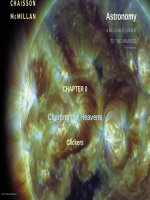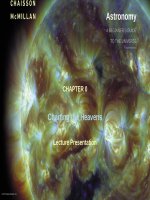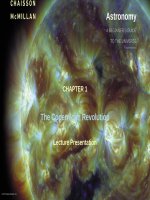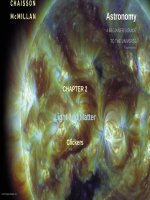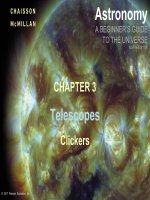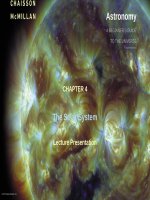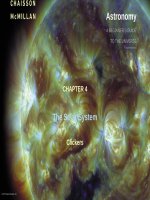Astronomy a beginners guide to the universe 8th CHaisson mcmillan chapter 07
Bạn đang xem bản rút gọn của tài liệu. Xem và tải ngay bản đầy đủ của tài liệu tại đây (2.7 MB, 31 trang )
Astronomy
A BEGINNER’S GUIDE
TO THE UNIVERSE
EIGHTH EDITION
CHAPTER 7
The Jovian Planets
Lecture Presentation
© 2017 Pearson Education, Inc.
Chapter 7 The Jovian Planets
© 2017 Pearson Education, Inc.
Units of Chapter 7
•
•
•
•
•
•
•
Observations of Jupiter and Saturn
The Discoveries of Uranus and Neptune
Bulk Properties of the Jovian Planets
Jupiter’s Atmosphere
Atmospheres of the Outer Jovian Worlds
Jovian Interiors
Summary of Chapter 7
© 2017 Pearson Education, Inc.
7.1 Observations of Jupiter and Saturn
•
•
Jupiter can be imaged well from Earth, even with a small telescope.
Here: Jupiter with its Galilean moons
© 2017 Pearson Education, Inc.
7.1 Observations of Jupiter and Saturn
•
True-color image of Jupiter
© 2017 Pearson Education, Inc.
7.1 Observations of Jupiter and Saturn
•
Natural-color image of Saturn
© 2017 Pearson Education, Inc.
7.1 Observations of Jupiter and Saturn
•
Cassini image of Jupiter,
true color
© 2017 Pearson Education, Inc.
7.2 The Discoveries of Uranus and Neptune
•
•
Uranus, in natural color
Note the absence of features.
© 2017 Pearson Education, Inc.
7.2 The Discoveries of Uranus and Neptune
•
Neptune in natural color
© 2017 Pearson Education, Inc.
7.3 Bulk Properties of the Jovian Planets
•
The Jovian planets are large and much less dense than the terrestrial planets; Saturn is
less dense than water!
© 2017 Pearson Education, Inc.
7.3 Bulk Properties of the Jovian Planets
•
Jovian planets, compared to Earth
© 2017 Pearson Education, Inc.
7.3 Bulk Properties of the Jovian Planets
•
Peculiarity of Uranus: Axis of rotation lies almost in the plane of its orbit. Seasonal
variations are extreme.
© 2017 Pearson Education, Inc.
7.4 Jupiter’s Atmosphere
•
Atmosphere has bright zones
and dark belts.
•
Zones are cooler and are higher
than belts.
•
Stable flow underlies zones and
bands, called zonal flow.
•
Simplified model:
© 2017 Pearson Education, Inc.
7.4 Jupiter’s Atmosphere
•
Jupiter has no solid surface; take the top of
troposphere to be 0 km.
•
Lowest cloud layer cannot be seen by
optical telescopes.
•
Measurements by Galileo probe show high
wind speeds even at great depth—
probably due to heating from planet, not
from Sun.
© 2017 Pearson Education, Inc.
7.4 Jupiter’s Atmosphere
•
The Galileo probe descended into Jupiter’s atmosphere and returned valuable data. The
arrow indicates its entry point.
© 2017 Pearson Education, Inc.
7.4 Jupiter’s Atmosphere
•
Major visible features:
–
Bands of clouds and the Great Red Spot
© 2017 Pearson Education, Inc.
7.4 Jupiter’s Atmosphere
•
Hubble Space Telescope (HST) observations of the Great Red Spot: Merging spots are
seen in the top sequence. Lower sequence shows the shrinking Great Red Spot between
1995 and 2014.
© 2017 Pearson Education, Inc.
7.5 Atmospheres of the Outer Jovian Worlds
•
The atmosphere of Saturn is similar to that of Jupiter, except that Saturn is somewhat
colder,
its atmosphere is thicker, and its bands are fainter.
© 2017 Pearson Education, Inc.
7.5 Atmospheres of the Outer Jovian Worlds
•
Saturn’s atmosphere is similar to Jupiter’s,
except pressure is lower.
•
•
It has three cloud layers.
Cloud layers are thicker than Jupiter’s; we
see only the top layer.
© 2017 Pearson Education, Inc.
7.5 Atmospheres of the Outer Jovian Worlds
•
Saturn also has large storms. This 2011 storm generated its own band, as seen in this
sequence of images from Cassini.
© 2017 Pearson Education, Inc.
7.5 Atmospheres of the Outer Jovian Worlds
•
This storm was observed by the Cassini spacecraft
in 2011 in visible light.
•
The right-hand image shows an infrared image taken after the band had faded in visible
light.
© 2017 Pearson Education, Inc.
7.5 The Atmospheres of the Outer Jovian Worlds
•
Saturn, like Earth and Venus, has enormous polar
vortices that resemble huge storm systems. The
southern vortex is shown in the top image, northern
vortex on the bottom.
© 2017 Pearson Education, Inc.
7.5 The Atmospheres of the Outer Jovian Worlds
•
Rotation of Uranus can
be measured by
watching storms.
© 2017 Pearson Education, Inc.
7.5 The Atmospheres of the Outer Jovian Worlds
•
Neptune has storm systems similar to those on Jupiter, but fewer. The large storm system
at the top has disappeared in recent years.
© 2017 Pearson Education, Inc.
7.6 Jovian Interiors
•
No direct information is available about Jupiter’s interior, but its main components,
hydrogen and helium, are quite well understood. The central portion is thought to be a
rocky core.
© 2017 Pearson Education, Inc.
